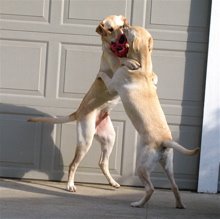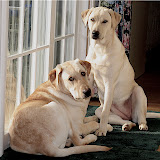Teaching your dog "Wait" vs. "Stay"
One of the most valuable things I have learned in the past 16 months in raising two Labradors is the importance of teaching my dogs self control.
Suzanne Clothier has a great short booklet on the subject called: "Understanding & Teaching Self Control". The training tips and advice in this booklet are a great resource and well worth the read. She sums up the importance simply:
"self control . . . leaves more of his mind available for learning and thinking instead of just reacting."One of the things I have found is that teaching both a "wait" and a "stay" as separate distinct commands helps with every day routines. As you can imagine with my Labradors, when the water hose comes out they get excited, Shelby in particular. This spring and summer with more free time I began expanding my garden so the hose was out a lot more. Teaching Shelby a solid "leave it", then a "wait" was well worth it. If all went well and I didn't have to drag him inside he got his reward at the end and the fun began. They both love to jump at the water as I play keep away. When it's hot I let him run right at it and chomp and mouth at the rushing stream. In their excitement they tear around the yard and than back to the water again. It's a great "life reward" and their ability to wait has gotten much better. The command "wait" lets us remote open the gate and drive the car into the driveway. They are eager to great us and I don't want to discourage that, but I also do not want them to rush at the car. "Wait" lets them know that they can come out but remain close to the house until we stop the car and close the gate. Then with a cheerful"release" they rush to the car door eager for us to get out. It is amazing to see how the skills carry over from situation to situation. They just seem to get it!! Proof again that a little time and solid training will go a long way to make life with dogs a real joy.© Copyright 1996 Suzanne Clothier
"Stay" on the other hand has allowed me to progress them to being off leash at our local park. I specifically choose quite and empty park times, or right at dusk when we gather with other dogs, to let them play off leash. In the mid morning when the field is clear I know that if another dog is walking the perimeter with it's owner I can put my dogs in a "down stay" and they know they can not move till I say so. This has especially been beneficial if a young child has wanted to come say "hi" to the dogs. I know that a "down stay" will hold my dogs allowing the child to approach without being intimidated as well as allowing the child to have a positive experience. "Stay" also has allowed me to anchor my dogs and leave them to approach someone who does not care to be close to dogs. It gives me the ability to respect others and be a responsible dog owning member of the community. It also gives me freedom to go places with my dogs because there are rules and they know what those rules are.
Great training tips:
When I started with basic obedience I figured we'd do an Obedience I & II and that was it; that I wouldn't need anything else. How hard could it be? They were dogs, weren't all dogs basically "good" dogs naturally? The answer is, "yes they are", but 6 months ago we both needed to learn how to communicate and understand each other better. My dogs needed to know where the boundaries were in their world. They didn't teach to this depth in the first class I enrolled in. But now, 6 months the wiser with our new trainer the answer is, "yes of course with the proper training, dogs will always be "good" seemingly naturally."















No comments:
Post a Comment